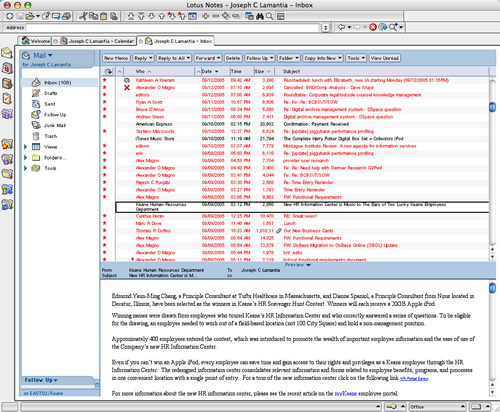User Experience: About To Be Commoditized?
Reading about the recent release of SocialText 3 I was struck by the strong parallels between the defining characteristics of enterprise environments in 2003/2004, and the emerging public Web 2.0 landscape. The essential characteristics of many enterprise environments are:
- Syndication: streams of modular content and functionality broadcast widely to subscribers within the firewall, such as enterprise data feeds, ERP, BI capabilities, CRM, custom capabilities shared via SOA
- Services (e.g. environmental, like the bees we used to have for pollination): identity, security, publication, data management, cloud storage, imap email, etc.
- Social Structures: tangible networks & communities of like-minded people, oriented around a common practice, purpose, process, or pain; think of all the matrixed, horizontal org structures and ad-hoc networks encoded via internal email lists, IM, sprawling intranets, corporate directories, etc.
These same attributes are emerging as the hallmarks of the public Web 2.0 landscape. This is how the three S’s manifest for Web 2.0:
- Syndication: A literal and figurative torrent of content in the form of blogs, RSS, feeds, streams, APIs, for social objects of all types, as well as catalogs of rentable content
- Services: This layer is growing rapidly for the public internet, with OpenID / OAuth, mapping, visualization, backup, calendaring – the list is nearly infinite, and still expanding
- Social Structures: The Web (and soon the mobile universe) is profoundly social now, and will continue to become ever more so.
I think you can easily see the strong parallels. It’s this similarity between the older enterprise environments and the emerging Web 2.0 environment that user experience practitioners, — and especially anyone practicing information architecture — should note.
Why? As I’ve written before, modularity is everywhere in this new environment, it’s apparent at all layers of the information world, from utilities like processing power, to services, to the elements that make up the user experience. The effects of modularity in syndication, services, and social structures on developers and IT have been profound; practices, processes, organizational structures, and business models have all shifted in response.
This wave of change first affected the developers who build and work directly with code and systems. But inevitably, disciplines further up the stack are feeling the impact of this shift, though many of us (and I’m putting user experience in this class) may not know it yet.
How will we feel that impact? One obvious way is in the pressure to adopt agile and other modular product construction practices created by and for developers as the preferred way to structure user experience and design efforts. This is a mistake that confuses the different stages of software / digital product creation (as Alan Cooper explained well at Agile2008). Design is not construction, and shouldn’t be treated as if it is. And one size fits all does not work when choosing the process and toolkit used for creating complex digital products, services, or experiences.
One result of this modularity rules all approach to user experience is the erosion of bounded or well-structured design processes that balance risk effectively for the various stages of design, and were meant to ensure the quality and relevance of the resulting products and experiences. Erosion is visible the trends toward compression or elimination of recognizable design concept exploration and usability verification activities in many design methods.
More immediately – in fact staring us right in the face, though I haven’t seen mention of it yet in m/any user experience forums – is the growing number of situations wherein there’s “No designer required”.
Examples of this abound, but just consider this feature list for the Social Text 3 Dashboard:
- You decide what matters
- Create your dashboard in minutes
- Include 3rd party information and applications
- Track & attend to what’s most important to you
- Status updates flow automatically, as you work
If that’s not specific enough, here’s what comes out of the box, in the form of pre-built widgets:
- My Conversations – changes others have made to any Socialtext workspace page you authored, edited, or commented on
- My Colleagues – recent updates made by people you are subscribed to
- Workspaces – workspaces you have access to and their activity metrics
- Workspace Page – any page from any of your Socialtext workspaces
- RSS Viewer – results of an RSS feed you configure
- Workspace Tags – a tag cloud of all tags in a particular workspace
- All People Tags – a tag cloud of all tags on people in Socialtext People
No architect required for most people here… and this trend is everywhere.
And then there’s the awesome spectre ofcommoditization. Listening to a friend describe the confusing experience of trying to select a short list of design firms for inclusion in an RFP made the linkage clear to me. I’ll quote Weil’s definition of commoditization from the paper referenced above, to make the point explicit.
Please recall that commoditization denotes the development of a competitive environment where:
- Product differentiation is very difficult;
- Customer loyalty and brand values are low;
- Competition is based primarily on price; and
- Sustainable advantage comes from cost (and sometimes quality) leadership.
- Commoditization is driven by excess capacity.
Please note that I’m not implying user experience practitioners face overnight obsoletion.
But I am saying that I doubt our current disciplinary worldview and toolkit adequately prepare us for the realities of the new environment emerging so rapidly. Code, by contrast, is and always will be modular. (After all, that is the defining attribute of our alphabets.)
But user experience is holistic, and has to learn to build in its own way from these smaller pieces like a writer combining words and phrases. Eventually, you can create works of tremendous depth, richness, and sophistication; think of Ulysses by James Joyce, or the Mahabharata. These are richly nuanced experiences that are the result of working with modular elements.
My suggestion for one response to the oncoming wave of modularity and commoditization is to focus our value proposition in the creation of tools that other people use to define their individual experiences. In other words, shift our professional focus to higher layers of abstraction, and get into the business of defining and designing frameworks, networks, and systems of experience components. Practically, this will mean things like observing and defining the most valuable patterns arising in the use of systems of modular elements we design, and then advising on their use to solve problems. This is the direction common within enterprise environments, and in light of the appearance of public pattern libraries (Yahoo’s UI), I think I see it happening within parts of the user experience community. I’m not sure it’s happening fast enough, though.
I hoped to communicate some of these ideas in my talk on why frameworks are the future (at least for anyone practicing Experience Architecture) for the 2008 EuroIA Summit that just took place here in lovely Amsterdam. I’ll post the slides shortly. In the meantime, what do you think? Is user experience ready for the modularized, enterprise-like environment of Web 2.0? How are you responding to these changes? Is commoditization even on your radar?
Comment » | Information Architecture, Tools, User Experience (UX)


